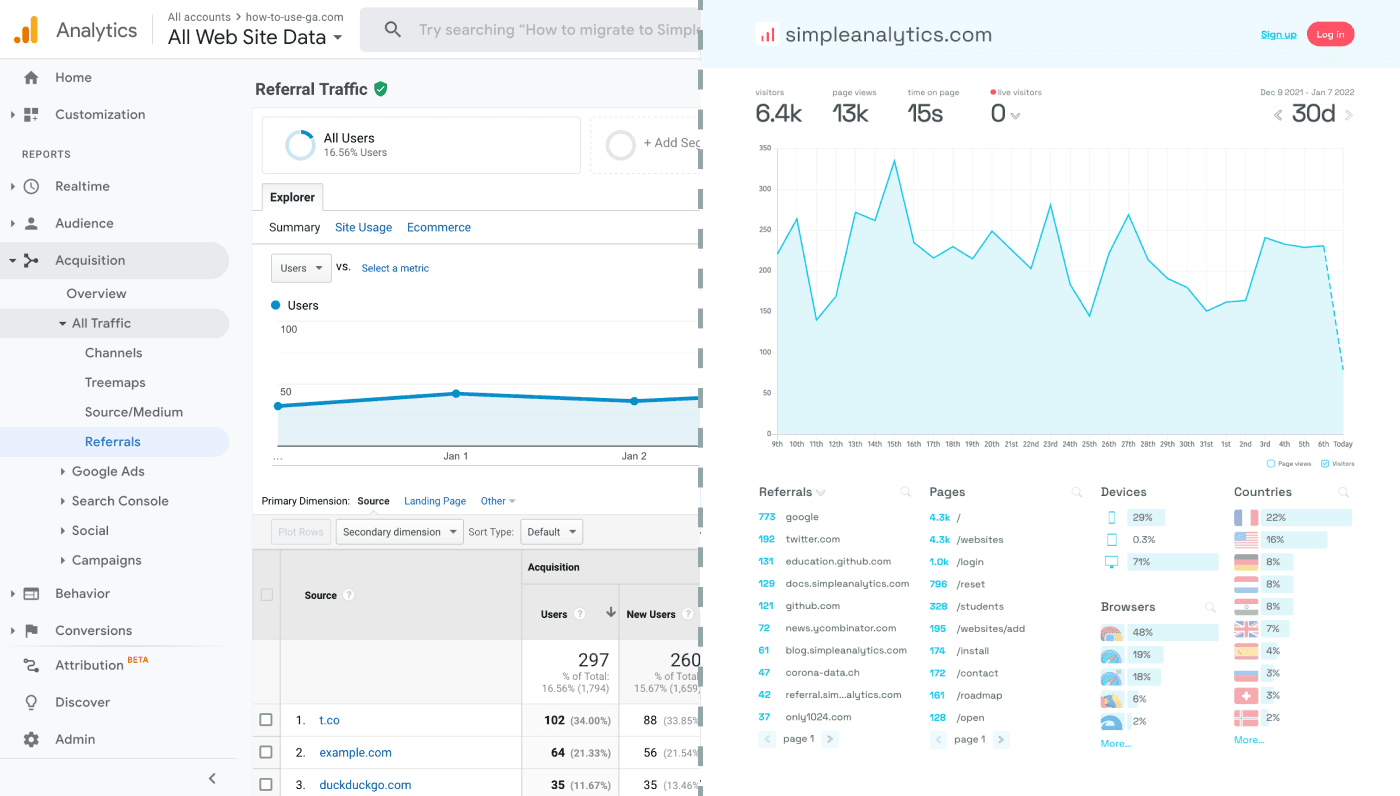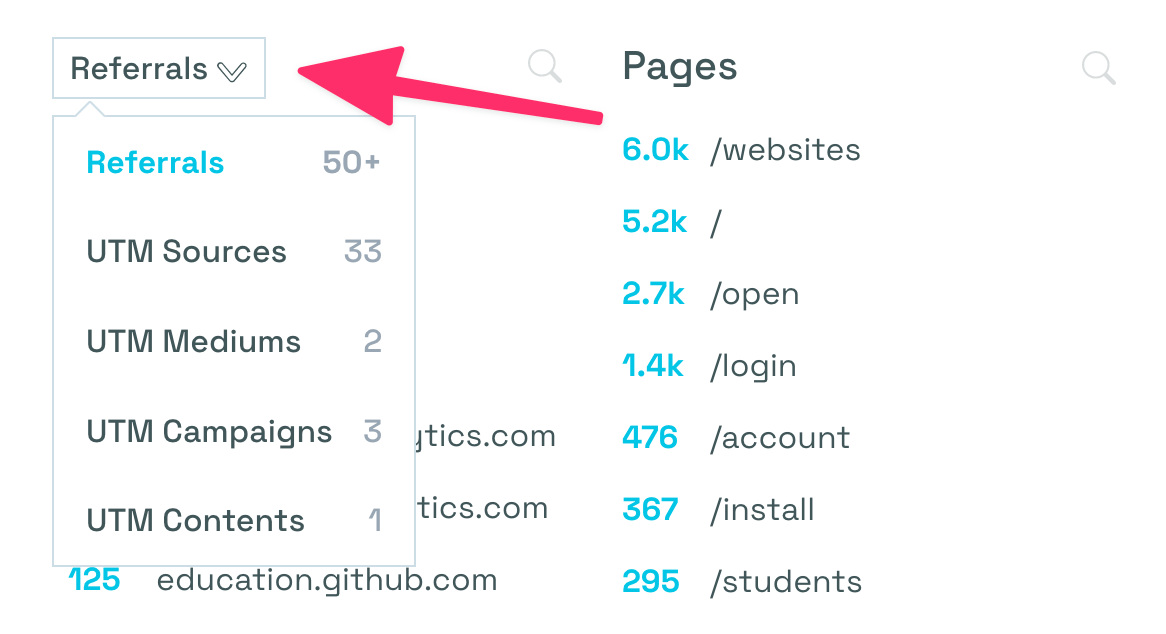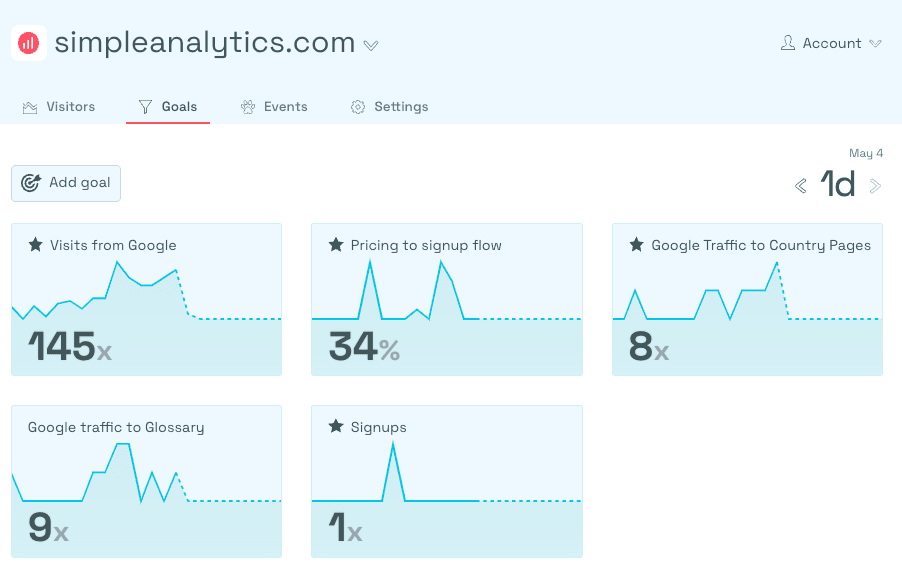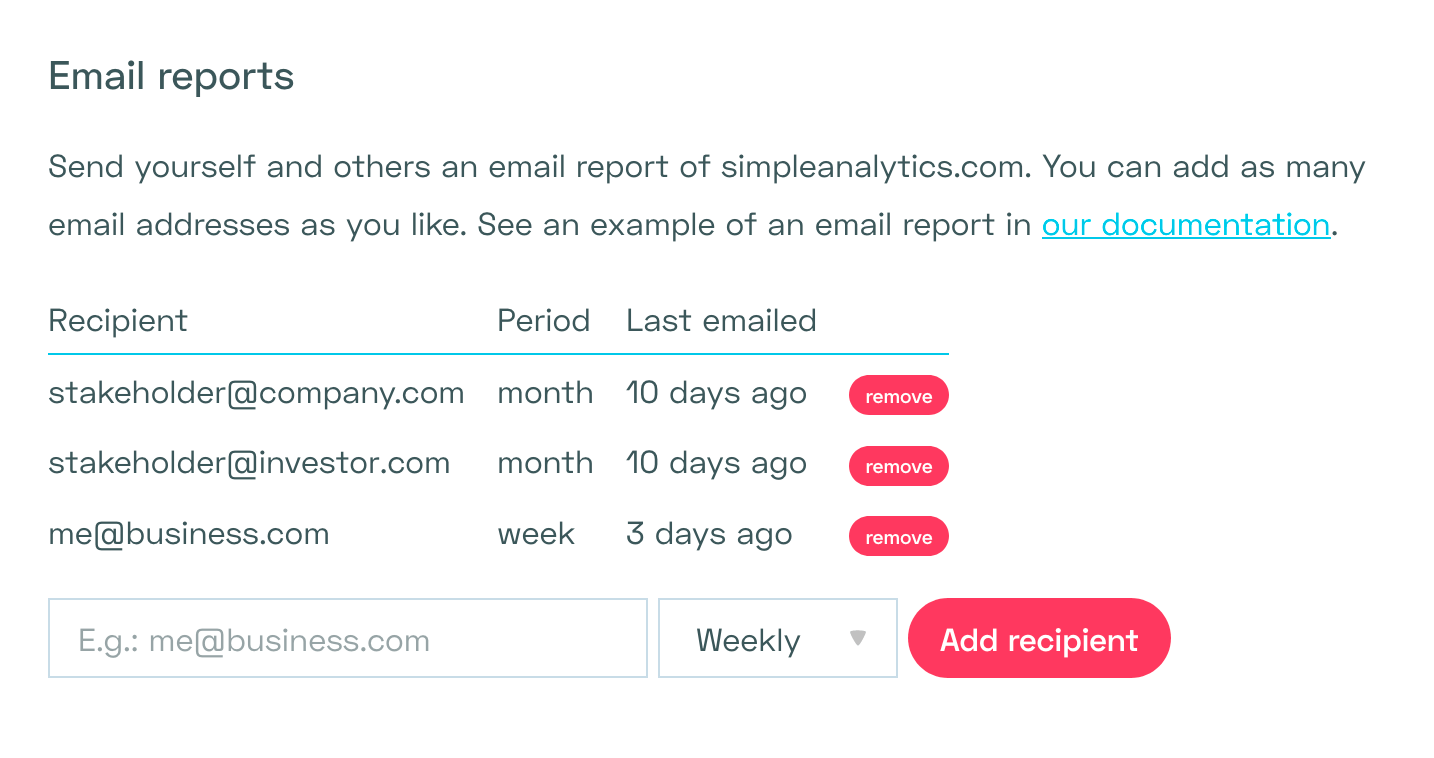Google Analytics has come under fire lately (and for a good reason). Multiple EU countries have already banned it, and more EU members are expected to reach the same conclusion. Also, Google announced it will sunset Universal Analytics in favor of GA4 on July 1st, 2023.
Now is the time to explore what other analytics tools have to offer. This article covers what Simple Analytics offers and how marketers use it.
- Get actionable insights from your analytics
- Content Tracking
- Keep track of your ad campaigns with UTM tags
- Add event tracking
- Create funnels with our Goals dashboard
- Use APIs to build your own dashboards
- Integrate Simple Analytics with your favorite dashboarding tools
- Import Google Analytics data directly into your dashboard
- Share reports with your team
- Get accurate website traffic data
- Benchmark Google Analytics data
- Improve your website's user experience
- Improve your core web vitals
- Comply with privacy regulations
- Try Simple Analytics
Let’s dive in!
Get actionable insights from your analytics
Simple Analytics is a straightforward analytics tool that provides the insights you need without compromising the privacy of your website visitors.
More privacy means less data collection and less information to do the marketer's job. However, more privacy does not always mean fewer insights.
We are called Simple Analytics for a reason. Retrieving actionable insights from Google Analytics can be painful. It provides an overkill of information by showing infinite menus and functions. We focus on what's important in a single-page dashboard that gives an accurate overview in seconds.

Our dashboard is fully customizable. You can create different views in seconds by filtering referrers, pages, traffic sources, countries, or browsers.
We have a live demo of our analytics. Feel free to play around with it.
Content Tracking
Like many businesses, we love to track how our content is doing. It’s important to see what is working and what is not to optimize your website. By using Simple Analytics functions and setting up goals in your dashboard, you can easily monitor the flow of users through your content conversion funnel. We’ve created a guide to show you how to track your content using Simple Analytics.
Keep track of your ad campaigns with UTM tags
We determine where visitors are coming from based on the (referrer) previous page. This information is retrieved from the visitor's browser. However, it's also possible to override this using a custom referrer. This might come in handy when you want to track specific ad campaigns.
UTM tags are bits of text you can add to a link that tell Simple Analytics a little more information about each link.
We support the following codes:
- UTM source (e.g.,
utm_source=company-x) - UTM medium (e.g.,
utm_medium=newsletter) - UTM campaign (e.g.,
utm_campaign=march_01) - UTM content (e.g.,
utm_content=button_red) - UTM term (e.g.,
utm_term=shoes, this parameter is deprecated as it is intended to contain user-generated content)
The UTM tags will show up on the dashboard in the "Referrals" dropdown menu:

Use our UTM Generator to create your UTM tags.
Add event tracking
Keeping track of events is important. In Simple Analytics, you can collect events such as downloads, sign-ups, and other outbound links. It is possible to fire events for any action taken by someone visiting your website.
To make it easier for non-developers, we created an automated events script. This script collects events for downloads and outbound links and clicks on email links automatically.
You can also create your own custom events if you want to get your hands dirty. Here is how you can set up your custom events.
Create funnels with our Goals dashboard
Once you collect events, you can use our Goals feature to create funnels. Setting up goals in your dashboard allows you to easily monitor user flow through funnels. The aim is to track and keep improving all the important metrics over time.

Use APIs to build your own dashboards
Simple Analytics does not own your data. You do! That's why we care a lot about the interoperability of your data. We will never sell or use your data for commercial purposes.
Most analytics companies do not give you access to your raw data. We believe it should be easy for our customers to get their raw data out of our database. You should decide what you want to do with it.
There are a few ways to interact with our API. We have the Stats API for aggregated data, the Export API for raw-level data, and the Admin API for changing users, websites, and other settings.
Integrate Simple Analytics with your favorite dashboarding tools
In addition to our APIs, it's also easy to integrate Simple Analytics with your favorite dashboarding tools. Some customers use Google Data Studio or Microsoft Power BI for building reports.
Because we care about privacy, we don't store any personal data. That's why we are comfortable enough to let customers choose to connect with Google Looker Studio while Google or Microsoft can't abuse our customers' data or their visitors'.
Import Google Analytics data directly into your dashboard
Importing your Google Analytics into your Simple Analytics dashboard directly and not losing any historical data is possible.
Google Analytics is shutting down its current version on July 1st, 2023. To keep your historical data, you can choose to import it into Simple Analytics. We built a GA Importer to import your data in just a few clicks.
With Simple Analytics, you can import both Universal Analytics properties and Google Analytics 4 properties.
Share reports with your team
Sharing actionable insights among team members is crucial to get everyone on the same page.
This can be a painstaking process in Google Analytics. Simple Analytics makes sharing insights easy. You can add team members to your Simple Analytics account and even make your analytics public to share it with just anyone.
In addition, we send weekly and/or monthly email reports, so you don't have to check the dashboard all the time. You can add as many team members (or other stakeholders to receive these reports and never miss that traffic spike. It includes the top 5 referrers and compares them with the previous period.

Get accurate website traffic data
This sounds contradictory: "Track less and get more accurate data." But this is essentially true, and there are a few reasons for it:
Cookie banners Before visiting your website, every website visitor needs to interact with a cookie banner. If the visitor does not consent to be tracked, you have no idea that this visitor has been on your website. More visitors will have visited your website than Google Analytics will show you. This discrepancy will only continue to grow as more and more visitors don't want to be tracked. If you use a privacy-friendly alternative that is cookieless by design, each actual website visit will be shown.
Adblockers More and more internet users are using ad-blockers because website users demand more privacy. Most ad blockers block the Google Analytics script. Visitors that have ad-blockers installed won't show up in your stats.
Referral spam Referral spam has been a big problem for Google Analytics. Referral spam looks like genuine traffic to your website, but it's actually fake.
At Simple Analytics, we built a feature that directly hides referral spam from your dashboard.
Data sampling Google Analytics uses data sampling to save server capacity and keep costs down. Data sampling means that only a subset of your actual traffic is processed. From this subset, Google Analytics predicts what your total traffic would look like. This is a cost-effective way to estimate website analytics. However, it is not nearly as accurate.
Benchmark Google Analytics data
It's no secret that Google Analytics is a really powerful tool that is very helpful for marketers to do their job. However, it comes with some caveats. The inaccurate data caveat, as explained above, might be a reason to use Google Analytics and Simple Analytics simultaneously.
If you heavily rely on individual user tracking, Simple Analytics might not be the right solution. We are a privacy-friendly solution. Google Analytics is better at tracking individual users, but it requires a cookie banner to do so. This makes your total website traffic numbers inaccurate. Therefore, we've seen multiple use cases that use Simple Analytics to get their actual traffic and use Google Analytics to dive deeper.
The fact that Simple Analytics is very lightweight means that you could easily run it next to Google Analytics or any other web analytics provider to see the differences.
Improve your website's user experience
If you use Google Analytics on your website to track your website performance, you are obliged by law to provide a cookie banner and ask for consent. This means your website visitors must first interact with a cookie banner before entering your website.
With Simple Analytics, this is not necessary anymore. Your visitors don't need to be shown a cookie banner when navigating to your website.
Improve your core web vitals
Simple Analytics improves your core web vitals. This is because Simple Analytics is a simple tool with a small script that needs to be installed on your website.
Analytics scripts differ in size; the bigger the script, the higher the impact on page load time. Bigger scripts slow down websites. The Google Analytics script (45kb) is a 'heavyweight' among web analytics scripts. In comparison, Simple Analytics' script is only (3kb).
A smaller script makes your website faster. This has two main advantages. First, this will improve your SEO score, and second, this will enhance your user experience.
We ran a performance test using Google Lighthouse to show the actual impact. There is a difference of 10 basis points in website performance between Simple Analytics and Google Analytics.

Comply with privacy regulations
Simple Analytics is fully compliant with privacy laws. Google Analytics is not. In some EU member states, using Google Analytics is against the law. Since it's a coordinated effort from multiple EU member states against Google Analytics, more countries are expected to reach the same conclusion as France, Italy & Austria did. The Netherlands is expected to conclude at the end of 2022.
An actionable agreement between the EU & US is still far away, and even if we reach this point, you can argue how sustainable it really is with the privacy movement getting more and more steam. Using Simple Analytics that is 100% compliant with GDPR gets the headache out of the way once and for all.
Try Simple Analytics
If you've read this far, it's maybe time for an introduction...
We are Adriaan & Iron, and we've built Simple Analytics to help create a more independent web that is friendly to website visitors. If this resonates with you, feel free to give us a spin!
